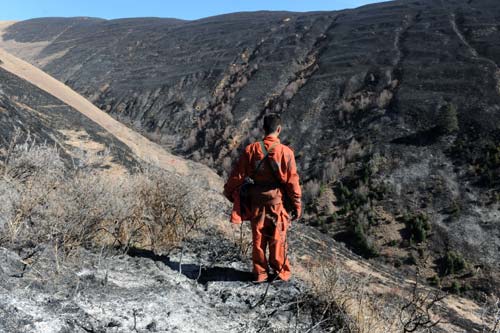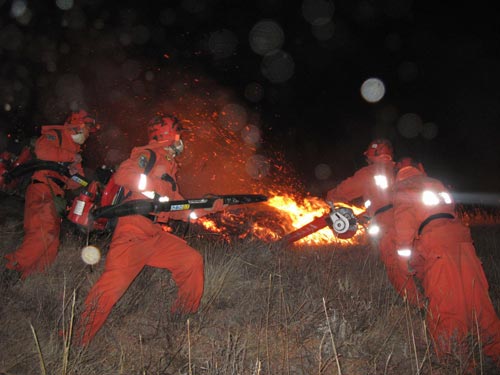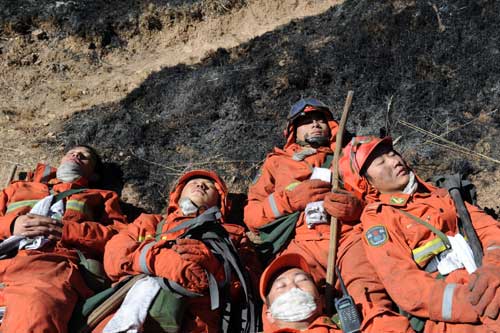Society
Technology may help save grasslands from fiery wrath
By Huang Zhiling in Sichuan and Jiang Xueqing in Beijing (China Daily)
Updated: 2010-12-09 07:49
 |
Large Medium Small |
 |
|
A firefighter looks at the devastated grassland in Garze Tibetan autonomous prefecture, Sichuan province, after the wildfire was extinguished on Dec 6. The fire destroyed 33 hectares of land. [He Haiyang / for China Daily] |
Due to the dry weather in Sichuan, which has one of the largest pastoral areas in China, wildfires are an annual occurrence.
However, this is the first that has resulted in fatalities, said Zeng Zhenggang, a leading official with the Sichuan Grassland Fire Prevention Office who has almost two decades of experience.
Information officer He Xing-hua explained that, each year, local governments in Garze print brochures and notices promoting basic details on fire prevention and firefighting in both Tibetan and Mandarin, distributing them to homes through the grasslands.
Officials also visit villages every winter to give lectures on what to do in emergencies, he added.
Situated in the southeastern swath of the Qinghai-Tibet Plateau, Garze covers an area of 152,600 square kilometers. From a population of 930,500, more than 78 percent are ethnic Tibetan.
In Dawu, which is home to rich forests, grasslands and water resources, about 89 percent of its 49,000 residents are ethnic Tibetan.
The country's early warning fire system is based on weather reports and analysis of the types of inflammable materials in a certain area. Experts argue that the model is not accurate enough and say there is no specific, detailed report on each grassland and forest.
According to the evaluation of its grassland vegetation and meteorology, Dawu is classified as one of the areas most at risk of spontaneous fires in China.
Due to the lack of roads, however, fire trucks cannot get to many of Sichuan's mountainous communities, and firefighters mainly use portable fire extinguishers, which are often criticized for being inefficient.
"More research should be done to develop practical firefighting technologies and methods, as well as portable equipment that is more efficient," said Song Weiguo, a researcher at the State Key Laboratory of Fire Science at the University of Science and Technology.
"With more advanced equipment and professional knowledge, firefighters will be better protected," he said.
In the United States and Canada, airplanes are usually the weapons of choice against wildfires, which has reduced their reliance on manpower.
The US also does a good job with risk evaluation, said Song, who added that the country's authorities send firefighting airplanes to the most endangered areas without wasting time and money.
"Compared to the US and other developed countries, China's evaluation of fire risks lags behind," he said. "We need to improve the accuracy of weather reports and enhance studies on how to classify different kinds of inflammable material."
In addition to funding from the Ministry of Science and Technology, the Chinese government also has a special fund for relevant non-interest scientific studies.
However, further investment is still needed to make rapid improvements, say experts, who also suggest the communication and cooperation between governments and relevant academic institutions should be enhanced.
"We hope to put the results of our research to practice as quickly as possible and receive feedback as soon as they meet problems in the real world," said Song.
He said that communication between his laboratory and officials is not as smooth and intent as it should be.


Keeping watch
 |
|
Firefighters work to extinguish the flames on Dec 5 in Dawu. Local authorities are still looking into the cause of the tragedy, which killed 22 people, including 15 soldiers and five villagers. [China News Service] |
There are two major causes of grassland fires: natural events, such as lightning or extremely dry and hot weather, and human error, such as a discarded cigarette or electrical fault.
The four methods China adopted to monitor its prairies are observation towers, ground patrols, air patrols and satellite supervision. Each has its own advantages and disadvantages, according to experts.
Satellites are said to cover all grasslands but they can only successfully detect 30 to 50 percent of blazes in a small scale because their resolution power is limited.
Air patrols, on the other hand, offer higher resolution power but cover a much smaller area and is more expensive.
Wildfires are naturally difficult to monitor with satellites as they rely on light during the day and thermal temperatures at night, said a source with the Sichuan meteorological station's agrometeorological center who did not want to be identified.
"When low bushes catch fire, the smoke is not as large as a forest fire, so there's a chance that satellite monitoring efforts may fail, (especially given that) highland temperatures are relatively low and that the perimeter of grassland fires is (often) not significant," the source added.
 |
|
Emergency workers take a rest after a hard day of fighting the wildfire on the Dawu grasslands. The wildfire raged for almost 24 hours, trapping dozens of soldiers and villagers. [He Haiyang / for China Daily] |
Hu Yinan contributed to this story.